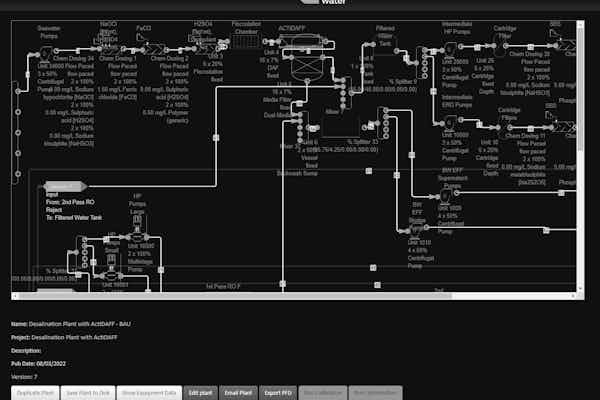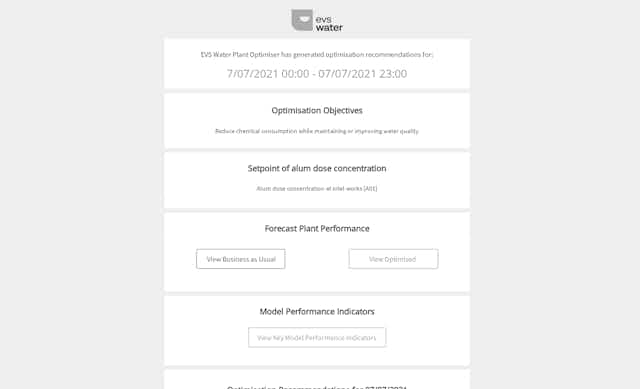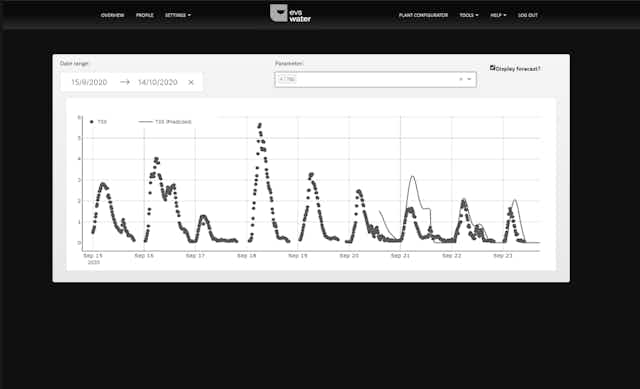
Plant Optimiser
Predictive water treatment optimisation software combining deterministic modelling and machine learning to improve the performance of municipal and industrial water treatment plants.

Plant Optimiser
Technology powered by deterministic modelling and machine learning
Uniquely powered by deterministic modelling and machine learning, Envirosuite’s Plant Optimiser helps operators real-time monitor and predict plant performance.
By quickly adapting operational settings to specific circumstances such as changes in feed water quality or quantity, operators can effectively mitigate risks, improve efficiency, reduce chemical and energy costs and extend the life of their assets while maintaining water quality.
Product Applications
Mitigate risk, optimise operations and extend asset life
Plant Optimiser distils complex data into highly accurate, simple and daily recommendations on process settings that are easy to understand, enabling efficient communications as well as rapid and confident decision making across different levels of the organisation.
Drinking water treatement
As feed water variability can be a pressing, Plant Optimiser enables drinking water treatment operators to optimise chemical dosing quickly and predictively, adapting to feed water changes to achieve consistent and reliable water quality while driving down operating costs.
Desalination
By recommending the most efficient operating modes, Plant Optimiser helps desalination operators reduce energy and chemical costs, reducing membrane fouling, and optimise maintenance cycles, reducing both operating and capital costs at desalination plants.
Industrial process water
Plant Optimiser can forecast and manage environmental risk for industrial water treatment operators by recommending the most efficient operating and dosing strategy to achieve your zero liquid discharge objective while delivering cost savings.
Inside the product
Distilling complex data into highly accurate, simple and daily recommendations
EVS Water Plant Optimiser enables efficient communication and rapid and confident decision making across different levels of the organisation.

Run plant-wide simulation
Plant-wide simulation and forecasts of feed water quality, flow, process chemistry, material balances and process performance.

Daily automatically generated email advice
The key setpoints needed to drive down operating cost and improve water quality are provided automatically by email to plant operators and engineers.

Add scenarios with “hypothetical” data
Assessment of possible outcomes for the modelled influent conditions allowing potential risks to be identified.

Hour-by-hour forecasts of optimum plant settings for up to 24 hours in advance
Every day, or every hour, Plant Optimiser automatically considers business-as-usual and alternative operating scenarios, up to 24 hours ahead, and identifies the most efficient mode of operation for your plant.

Customer service
World-class service
Operational and design data can be taken from the existing monitoring network or process monitoring systems.
On-site or web-based training is provided to every customer as part of subscription fees.
Ongoing support is provided via our 24-hour global support portal, which includes in-house water industry experts to guide you in the most efficient use of the system.
FAQs
Here are answers to common questions about Plant Optimiser. Reach out to our team today if you don't see the answer you are looking for.
EVS Water uses recurrent neural networks (RNN) powered by TensorFlow and Keras to calibrate models around a deterministic baseline. These tools have been chosen as they are widely accepted frameworks for applying recurrent neural networks to challenges requiring identification of patterns in complex data sets.
These frameworks are production-focused and integrated into the source code to enable accurate forecasts for EVS Water applications and allow for relatively rapid implementation and processing times. Input features to the RNN may include Feed/Coagulation pH, DOC, UV254, Temperature, Feed/Lamella Overflow Turbidity and coagulant dose, using both existing and a vendor installed instruments.
Sorption Capacity used in the deterministic model is also further calibrated by this RNN model to site specific conditions. The detailed design of the RNN models is developed as a result of close engagement with the customer and site personnel and depends on the design of the plant and available monitoring data.
We use a procedure for forecasting time series data based on an additive model where non-linear trends are fit with yearly, weekly, and daily seasonality, plus holiday effects. It works best with time series that have strong seasonal effects and several seasons of historical data. It is also robust to missing data and shifts in the trend, and typically handles outliers well.
Although technically feasible to connect with DCS/SCADA systems it is recommended that data for Plant Optimiser are obtained from the data historian rather than the DCS/SCADA system. Latency between DCS/SCADA systems is not typically of concern in applications of this type, which require approximately hourly resolution in data.
Further DCS/SCADA connected applications are typically associated with much longer timeframes associated with permissions and policies related to accessing the data stored there. Data historians (e.g. PI) are designed to interact with a wide variety of stakeholders including 3rd party vendors and we are confident that one of our three preferred methods for data management (code to Envirosuite’s API, ftp transfer to a WSD site, or ftp transfer to an Envirosuite site) will be accepted. Alternatives to this design will require a variation to the scope of work in this proposal.
The deterministic baseline for coagulation recommendations are based on a number of key models including a modified version of the Edwards (1997) Langmuir based coagulation model which is developed specifically for representing enhanced coagulation using aluminium and ferric salt based coagulants, considered the most accurate of the available models for DOC removal during coagulation (Tseng and Edwards, 1999).
The key inputs for this model are feed DOC [mg/L] and feed/coagulation pH which lead to a prediction of coagulant dose [mg/L], based on a recent inorganic analysis or online alkalinity measurement if available.
PIDs, PFDs, monitoring points, representative monitoring data, dosing locations, equipment datasheets will be required to be shared at the start of the project. Data for nominated monitoring points will need to be shared at least daily during the operational phase of the project with protocols agreed at the start of the project.
To facilitate an evaluation of financial benefits, average unit cost of chemicals, electricity consumption, solid waste disposal and labour cost for the plant will be requested at the start of the project.
1. Forecast water quality for each nominated feed stream
2. Forecast dosing requirements
3. Forecast energy requirements
4. Simulated forecast of the treatment operation as per configured digital twin
5. Daily advice of operating setpoints to achieve operational and environmental targets
6. Red flags at critical control points / operation outside equipment guidelines
The Plant Optimiser solution is designed to cover the whole water or wastewater treatment process and provide recommendations related to the operating and environmental objectives at that particular plant. Forecast recommendations are then focused on particular unit operations likely to deliver the greatest savings or best improvements in water quality. Having said this, key dollar savings typically relate to energy consumption or chemical/consumable consumption.
The system is currently an advisory system and does not connect directly to devices. Recommendations still need to be manually implemented by the operating team. Any unauthorised personnel would not have remote access to the customers' chemical control systems.
Want to know more about Plant Optimiser?
Find out how Environmental Intelligence can help you unlock value beyond environmental compliance and empower you to make confident operational decisions.
Get in touch with us and learn more about how you can act faster, perform better and operate at full potential.
Ready to talk?
Learn more about Plant Optimiser case studies and latest insights.
OTHER EVS WATER PRODUCTS
Other EVS Water products you may be interested in
about your operational challenges.
